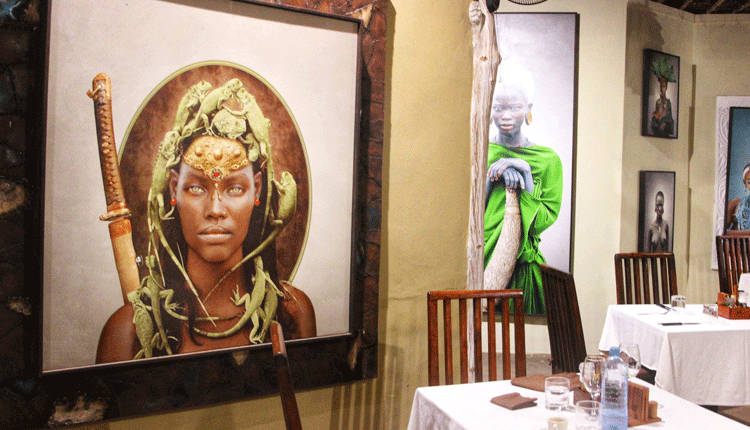The art moves from the gallery to hotel

In the past, getting a deal with a gallery was a watershed moment in an artist’s career.
Galleries take the works of artists to art fairs both locally and internationally, assists the artist cultivate a collector base, host public exhibitions, supplement or advance fabrication costs, and produce publications about the artist.
But in the quest of seeking new markets and money, artists are now selling their art to hotels, malls, restaurants, offices, hospitals, and homes, some ditching working with galleries because of their restrictive nature.
“In reality we have simply gone back to basics. Art galleries are an invention of the art market.
Art is one of the greatest expressions of human intelligence and must be available to everyone as it was in the past in places such as the churches where people went every week.
Seeing works of art around us consoles us; it makes us more confident towards others.
Living surrounded by works of art certainly makes us better,” Malindi-based artist Gianpaolo Tomasi tells Spice.
Years back, Gianpaolo quit selling his art to galleries because he felt it restricted his creativity and only benefited a few people who could afford the art.
“What sense does it make to close them inside containers that are not popular and only accessible to a few wealthy people? To me, the sale is a consequence not the purpose or mission.
The mission is to spread the beauty, which is intelligence because for instance, there are no exposures in hospitals, and perhaps recognise a commission in favour of the sick.
Why must works of art have such high value in some cases? Who benefits from the art business?
I choose to exhibit where people live because this is the mission of those who want to make art,” he adds. 
Giampaolo believes that Kenyan artists have a great opportunity to transform how art is done and that creativity is changing even in the art space.
“Art can change the world, that’s why it has to be among people. The works must be taken out of museums and galleries and exhibited permanently in public places,” he says.
Marketplace dynamics
James Kimathi, the founder of Sketchmasta School of Art, thinks that the shift is influenced by the search of clientele and that it doesn’t mean the ultimate death of galleries.
“Not many people make it to the art galleries, but you will find a lot of art lovers in hotels, malls and other public places.
I think it’s just a matter of taking work where the buyers are, which is sometimes influenced by what has been your experience in dealing with both the galleries and other places.
There is a balance in both as there will always be visitors at galleries and art shows,” he notes.
According to him, what matters by the end of the day is the sale of art. “Artists can’t really dictate where to sell their work, as they will meet as many buyers in galleries as you will meet in hotels.
I would advise galleries to diversify by featuring different if not all art genres. That way, they will have everyone represented,” he says.
For Tamarind Tree Hotel in Nairobi, the desire to support artists started three years ago.
A lot of artwork beautifies the walls at the reception area and restaurant. The facility opted for this path to support local artists, but also to give travellers an authentic travel experience by immersing themselves in the art culture. 
“Art is the first thing that guests notice when they set foot in a hotel. It draws guests and makes them feel welcome.
Artwork from local artists can intrigue the guests; assist them to learn more about culture and our people.
They can also understand the history of the place they have visited and helps them have a visual connection with the place they are visiting,” intimates the hotel’s GM John Musau.
Art expert, researcher and producer Junniah Wamaitha believes that this shift doesn’t mean the death of galleries, as they constantly have art lovers visiting them.
It’s their restrictive nature that has made some artists diversify into new markets.
“Galleries are not giving artists conditions they can thrive in. Some are too strict, while others are working exclusively with specific artists or collectives.
So, what happens to solo artists whose art style is not what a gallery owner wants?
There is a big disconnect with how artists and galleries work and how lucrative their deal is with the artists.
One, because there are galleries that charge entrance fees and this does not translate back to the artist,” she observes.
Thaddeus Mutenyo Wamukoya aka Thadde Tewa is a Nairobi-based Kenyan contemporary art curator, writer and consultant.
He runs Tewasart and Patrons, an online gallery and arts consultation platform focused on promoting East African contemporary artists to a wider audience.
He started the venture after working for a gallery in Karen for three years and noticing that it focused more on the clients rather than the artists.
“I quit my job in 2019 after realising that key galleries in Nairobi focus on the clients and narrative that will make clients buy the artwork.
I wanted to start my own to represent artist and shift the paradigm, and change the way even the consumers see the artist. My curatorial practice is based on studio visits and artists,” he explains.
Disproportioned interests
Thaddeus believes that galleries are important in the business of an artist, but restrictive, as their main aim is to make money from the artist.
“That’s how the game is. There are those artists who are willing to play their cards, but many of them get into complicated situations because galleries are like managers.
They manage artists and give them the brand. For instance, an artist can be earning US$100, but they need to do more to earn more.
A gallery gives it the final polish, a different feeling, so that when the client comes they know the value of the painting.
While some need the galleries, others don’t. They also assist the Kenyan artists access the international market.
I want to increase this number to change the game and not just have one or two galleries monopolising the scene,” he notes.
He advises artists to be more knowledgeable about the contracts they sign, instead of only being interested in receiving commission.
“Internationally, artists get more value because they ask more questions and hence they gain more.
Artists settle for less and they should push galleries to give them more because when they are singling you to work with them, they already know how much they will make from you.
Also, artists should operate like a corporate and have legal partners in case their payments are defaulted,” he recommends.
Ten years ago, William Ndwiga founded the Little Art Gallerly to largely focus on the local market.
He observes that the opening up of restaurants and hotels has an effect on the art sector, as it creates more platforms for artists to sell their work.
“Artists need to be empowered to articulate and negotiate for better deals as this will better the market for the artists. There is exclusive representation in galleries.
The industry is young and doing that alienates artists and creates a ‘class’. By doing that you are denying market creativity.
An artist is sort of guided on what works for the gallery and they are bound to produce what only works for the gallery rather than what they are great at,” he explains.
While galleries are important, Ndwiga says they are not the industry. He says, “They are just part of the players in the industry. If the industry is strong, they will survive, and vice versa.”
Art appreciation
Artist Michael Musyoka prefers selling his art through galleries because the art is more appreciated there than in a restaurant where it only serves as a backdrop for diners.
“Well, there is a standard or quality of work that a gallery accepts based on their taste and preferences, but they don’t control what the artist makes. I wouldn’t call it restrictive; maybe choosy,” he says.
Michael feels that galleries are important to the artist because they take away the hustle of selling work, thus letting the artist create in peace.
“They also assist to broaden an artist’s audience both locally and internationally. Some galleries participate in international art fairs, thus helping to push an artist’s name and work to new audiences.
They assist in appraising and validating the value of an artwork. They are important to the art collector because they are the best art market places to source for new art or creative expertise, especially for newcomers or tourists as not everyone has the time or ability to visit an artist’s studio.
Sometimes they just don’t know where to start. They are also the best places to resell artworks (secondary art market),” he says in ending.



